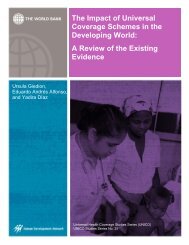11ZAQGM
11ZAQGM
11ZAQGM
Create successful ePaper yourself
Turn your PDF publications into a flip-book with our unique Google optimized e-Paper software.
Impacts<br />
BIODIVERSITY IMPACTS<br />
Abrha Weatsbha’s Natural Resource Management Initiative has had a<br />
number of positive biodiversity impacts in the land surrounding the<br />
village and in the region more broadly. Environmental rehabilitation<br />
efforts – the construction of dams, trenches and bunds, and chains of<br />
ponds for “water banking” – have had the desired effect of recharging<br />
the ground water and improving the integrity and composition of the<br />
soil, two challenges which had long been plaguing the community<br />
and crippling the health of local ecosystems.<br />
Recharging groundwater<br />
Rehabilitation efforts, along with a wide-ranging tree planting<br />
campaign, have resulted in more than 50 per cent of rainwater being<br />
trapped to recharge groundwater stores. Wells have been dug for<br />
irrigation of high-value crops, which are now able to be harvested<br />
two to three times per year, irrespective of rainfall patterns. The<br />
creation of enclosure areas and water conservation measures have<br />
resulted in water tables rising from nine meters depth to between<br />
two and four meters, making the digging of wells a reasonably lowlabour<br />
and low-cost proposition. Natural springs that had dried<br />
up have started to flow again, streams now flow longer distances,<br />
and pastured lowlands remain green throughout the year. The<br />
environmental benefits of soil conservation, water infiltration<br />
and groundwater recharge have translated to socioeconomic<br />
benefits that include higher crop yields, improvements in biomass<br />
production, and reduced incidence of flooding.<br />
example, where farmers used to purposefully remove Faidherbia<br />
albida trees – a thorny species of tree with deep-penetrating tap<br />
roots that make it highly resistant to drought – it has become<br />
common practice to sow their seeds and germinate them in their<br />
fields. Another example of positive behavior change among local<br />
farmers has been the voluntary introduction of seasonal land<br />
closures, where human and livestock incursions are restricted to<br />
allow land in certain areas to recover.<br />
A sustainable land management approach<br />
One of the main areas of focus for the initiative has been tree planting,<br />
efforts which have targeted hillside areas and degraded lands in and<br />
around the village. These investments in tree planting have paid<br />
large environment dividends. Reforestation has translated to the<br />
conservation of topsoil, greater cycling of organic material to the<br />
soil, watershed protection and reduced erosion of hillsides, which<br />
A “quiet revolution”<br />
Abrha Weatsbha Natural Resource Management Initiative has<br />
successfully ushered in a local paradigm shift – what the group<br />
has dubbed a “quiet revolution” – in how local farmers understand,<br />
appreciate and manage the environment. One aspect of this<br />
appreciation has been around indigenous species of plants. For<br />
16






